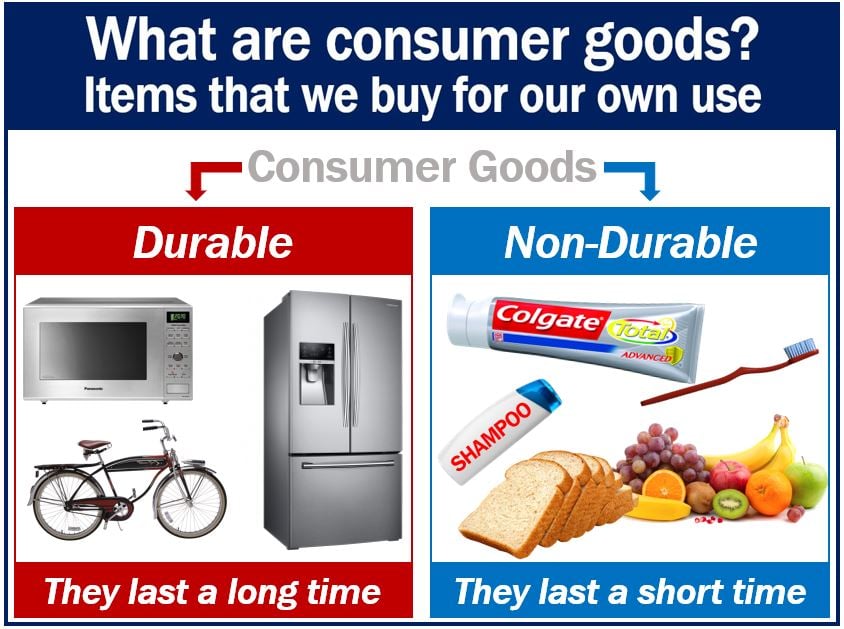Consumer Goods are products that people buy and don’t use to make other things that are then sold. We can also call them final goods because when somebody buys them, they have reached their final destination.
Consumer goods are the end result of manufacturing and production. They are what we see on supermarket shelves. All the food and drink that we purchase in the supermarket, for example, are consumer goods.
What are consumers?
Consumers are people or other entities that buy goods or services. A person who uses a good or services that he or she buys is a consumer. Consumers do not sell what they bought – they ‘consume’ them. Hence, the name.
In the marketplace, consumers are key figures. Most of the activities of the sellers and makers of products and services are focused on consumers.

Consumer goods vs. capital goods
Goods are products. In other words, things that we grow or make and try to sell to buyers. We exchange money, for example, for goods and services.
Capital goods
Capital goods are things that businesses buy to make other things. These type of goods last a long time, i.e., they are durable.
Factory machinery, vehicles, and computers, for example, are capital goods.
Consumer goods
We do not buy a consumer good to make something else that we aim to sell. When somebody buys a consumer good, he or she uses it. These goods satisfy personal needs and not the needs required for the production of other products.
Durable and non-durable goods
What is the difference between durable and non-durable consumer goods?
Durable
Durable goods are things that last a long time. Refrigerators, TVs, and bicycles, for example, are durable goods. We do not buy them every week or every month.
Non-durable
We all buy food and drink on a regular basis. We buy bread, for example, usually at least once a week. Bread is a non-durable good. Drinks, shampoo, razors (for shaving), and food, for example, are non-durable goods.
If something is non-durable, it means that it does not last for a long time.
Three types of consumer goods
We classify consumer goods into three categories:
Durable goods.
Non-durable goods.
Services – the non-physical, intangible part of a nation’s economy. We cannot touch, see, or handle services. Education, transportation, window-cleaning, and banking, for example, are services. I cannot touch banking, nor can I weigh it or measure its length.
Services represent the main parts of the economies of the US, UK, and other rich nations. Even among the emerging nations today, services make up more than half of their GDPs. GDP stands for Gross Domestic Product.
White goods and brown goods
White goods are large household appliances such as freezers, stoves (British: cookers), refrigerators, washing machines, and dishwashers.
Brown goods are relatively light electronic appliances such as radios, computers, game consoles, digital media players, and televisions. They are portable and semi-portable household electrical/electonic goods.
Both white and brown goods are consumer goods.
The production and disposal of consumer goods significantly impact environmental sustainability, prompting initiatives for more eco-friendly manufacturing and recycling practices.
Synonyms of “consumer goods”
The following terms have the same meaning as “consumer goods.” Below, you can see them used in context:
Final Goods or End Products
Products that have completed the manufacturing process and are available for purchase by the end consumer.
Example: “The economic report primarily focused on the sales of final goods (end products) to assess consumer spending trends.”
Retail Goods
Merchandise sold directly to the consumer, typically through outlets such as stores and online marketplaces.
Example: “She found a wide selection of retail goods available on the new shopping website, ranging from clothing to electronics.”
Consumer Products
Goods intended for the use and consumption by individuals and households.
Example: “The trade fair exhibited a variety of consumer products, including innovative home appliances and personal care items.”
Ready Goods
Merchandise that is prepared and available for sale without the need for any additional processing.
Example: “The bakery showcased its ready goods early in the morning, tempting passersby with fresh bread and pastries.”
Non-capital Goods
Goods that are not used in the production of other goods and are instead purchased for immediate or near-term consumption.
Example: “Most households spend a larger portion of their income on non-capital goods compared to businesses.”
Fast-moving Consumer Goods (FMCG)
Products that sell quickly at relatively low cost, often with a short shelf life, such as packaged foods, beverages, and toiletries.
Example: “The supermarket’s profit margins were particularly high on fast-moving consumer goods due to their quick turnover.”
